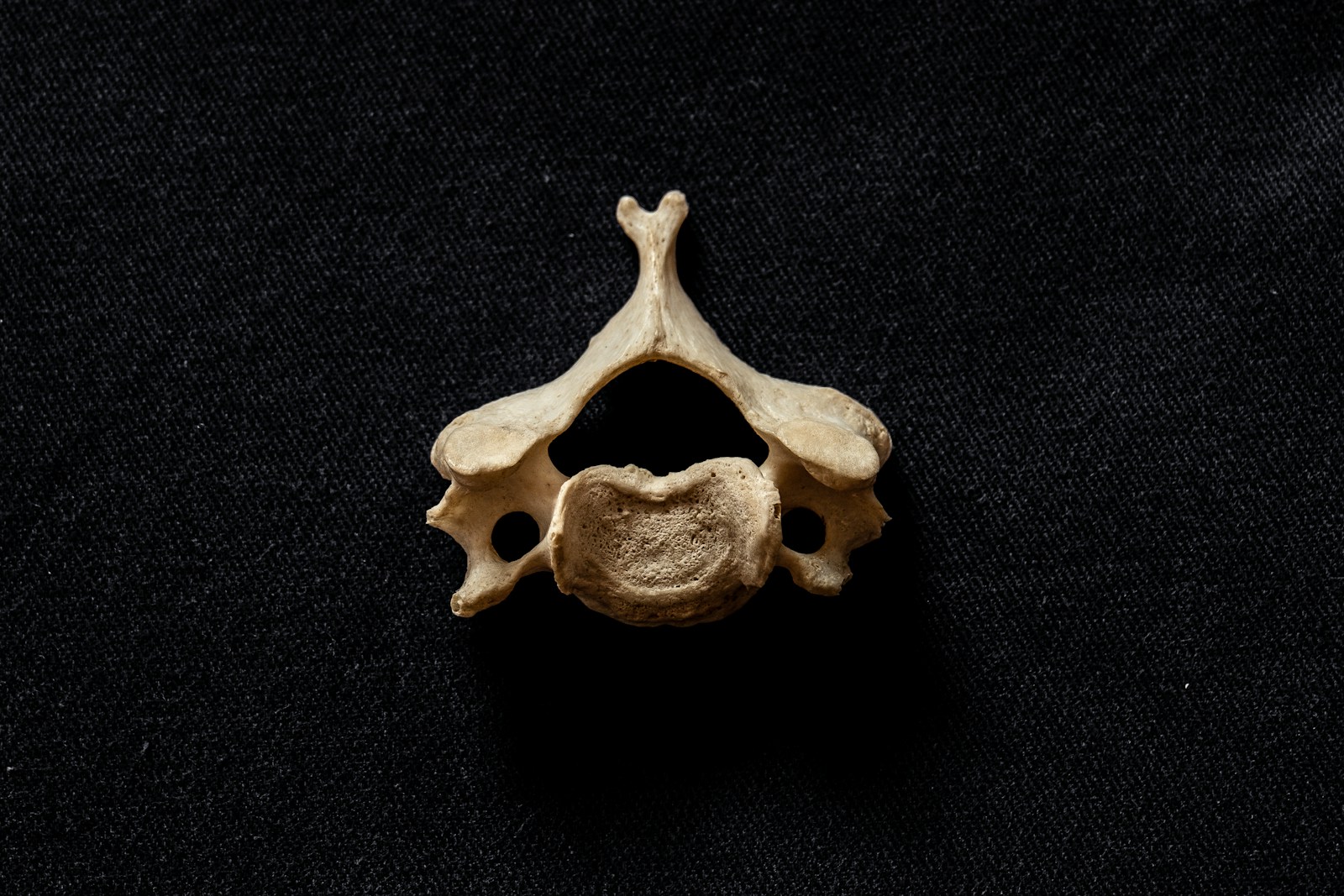The cervical vertebrae, a set of seven stacked bones in the upper spine, play fundamental roles in human anatomy. They provide structural support to the skull, enable complex neck movements, and protect the spinal cord, a main neural communication pathway. Features like the atlas and axis, developmental stages, and health implications warrant further exploration. The ensuing discussion illuminates these crucial areas.
Understanding Cervical Vertebrae
The cervical vertebrae, a set of seven structured bones in the upper spine, support and enable neck flexibility. The evolution of these structures varies among species, influencing both their lifestyles and survival strategies. Humans and giraffes both have seven cervical vertebrae, while some birds and sloths possess up to 25 and 28 respectively. These variations result from evolutionary adaptations to specific environments. For instance, a sloth’s numerous vertebrae allow for extreme neck flexibility, aiding survival in arboreal habitats. Thus, cervical vertebrae study is crucial in both human anatomy and evolutionary biology.
Anatomy of Cervical Vertebrae
The human cervical vertebrae, comprising seven bones labeled C1-C7, support the head and enable neck mobility. These bones develop embryonically through somite segmentation and recombination, forming distinct features for each vertebra. The first two, the atlas (C1) and axis (C2), have unique structures that allow nodding and rotation. The remaining vertebrae (C3-C7), while structurally similar, have bifurcated spinous processes for enhanced flexibility. The evolution of these structures has facilitated human upright posture, increased motion range, and head weight support, marking a crucial step in human evolution.
Cervical Vertebrae Functions
The cervical vertebrae, integral to human physiology, enable spinal mobility, including rotation, flexion, and neck extension movements. Crucially, they also safeguard the spinal cord, facilitating essential neural communication between the brain and body.
Structure of Cervical Vertebrae
The cervical vertebrae, designed to support the skull, facilitate spine movement, and safeguard the spinal cord, exemplify human biomechanics complexity. These seven uniquely shaped vertebrae each perform a specific function, with their development initiating in utero, specifically ossifying first in the cervical region. A cervical vertebra comprises a vertebral body, a vertebral arch and seven processes. The first two, atlas and axis, distinct in anatomy, enable head rotation. The subsequent five, while more uniform, maintain key roles in cervical spine balance.
Role in Spinal Mobility
Cervical vertebrae, integral to daily activities, are pivotal for spinal mobility, offering stability and flexibility. These seven vertebrae enable complex motions such as axial rotation, lateral flexion, and bending. The cervical vertebrae’s unique articulations and biomechanical properties contribute to spinal flexibility, crucial for kinetic life. However, aging or trauma can trigger vertebrae degeneration, reducing spinal function, flexibility, and causing stiffness and pain. Understanding cervical vertebrae’s role in spinal mobility is vital for diagnosing and treating vertebrae degeneration-related conditions, ensuring effective spinal health maintenance.
Protection of Spinal Cord
The cervical vertebrae serve a critical function in protecting the spinal cord, a crucial neurological pathway. These bones act as a shield, reducing spinal cord injury risks. Due to their closeness to the brain, they effectively prevent traumatic injuries from impacting the spinal cord. This protection becomes vital during vertebrae degeneration, which can cause spinal cord compression. The vertebral foramen, a hollow space within each vertebra, provides further protection by housing the spinal cord. This efficient design ensures reliable spinal cord protection, highlighting the crucial role of cervical vertebrae in preserving neurological health.
Number and Arrangement
The human neck comprises seven cervical vertebrae, specifically arranged from C1 to C7 for optimal functionality and structure. The evolution of vertebrates over millions of years has resulted in this precise sequence. These smaller vertebrae, compared to those in other spinal regions, provide greater movement scope. The first two vertebrae, the atlas (C1) and axis (C2), possess unique shapes that facilitate nodding and rotational head movements. This vertical stack forms a ‘C’-shaped lordotic curve, ensuring balanced head support and shock absorption during motion. The strategic location of the cervical vertebrae optimizes the spinal cord and nerves’ function passing through the cervical region, reinforcing the cervical vertebrae’s number and arrangement’s significance for health and well-being.
Cervical Vertebrae Features
Cervical vertebrae, the smallest in vertebrae development, are unique in structure to support wide motion range and skull. They feature a foramen in each transverse process for vertebral arteries passage. The first two – atlas (C1) and axis (C2) – are specialized for head rotation and flexion-extension. Atlas lacks a vertebral body, sporting an anterior and posterior arch. Axis has a unique dens or odontoid process. Cervical degeneration changes these features. Intervertebral discs lose elasticity and shock-absorption, leading to spinal canal narrowing or cervical spondylosis. Degeneration can also cause bone spurs, impinging nerve roots and causing pain and radicular symptoms.
Importance of Cervical Curvature
Cervical curvature, or lordosis, is crucial for vertebral column function, balance, shock absorption, and flexible movement. Cervical pillows aid in maintaining this curvature by supporting the neck, reducing pressure, and preserving the natural curve during sleep, thereby preventing neck pain and enhancing sleep quality. Posture correction techniques, which include exercises and habit changes, fortify neck and upper back muscles, ensuring proper neck alignment and promoting ideal curvature.
Common Cervical Vertebrae Disorders
Cervical vertebrae disorders, often arising from injury, aging, or disease, significantly impact health and activities. Two common disorders are Cervical Spondylosis and Cervical Disc Disease. The former, also known as neck osteoarthritis, results from cervical vertebrae wear, frequently observed in older individuals. The latter involves intervertebral discs losing hydration and elasticity, leading to a herniated or bulging disc and causing intense pain. Dietary measures, including calcium, vitamin D, and omega-3 fatty acids, can assist in managing these disorders by maintaining bone density and reducing inflammation. Furthermore, exercises targeting cervical vertebrae can strengthen neck muscles, providing spine support and stability, potentially mitigating injury or degeneration risks.
Symptoms of Cervical Conditions
Cervical vertebrae conditions manifest as neck pain, stiffness, or numbness extending to the shoulders and arms. Early detection is crucial to prevent further complications and implement pain management techniques and lifestyle changes.
Pain, subjective and varying in quality and intensity, can range from sharp to dull, throbbing to burning. Persistent pain varies among individuals. Neck stiffness can limit motion range, disrupting daily activities and reducing life quality. Numbness or tingling in the arms and shoulders may indicate nerve involvement, signaling severe cervical conditions requiring immediate attention.
Pain management techniques are vital to lessen discomfort and enhance functionality. These include pharmacological interventions, physical therapy, and in certain cases, surgery. Concurrent lifestyle modifications such as regular exercise, correct posture, and healthy weight maintenance can significantly enhance management strategies by boosting spinal health and resilience.
Diagnosing Cervical Vertebrae Problems
The diagnostic process for cervical vertebrae conditions involves physical examination, patient history analysis, imaging techniques, and laboratory tests. The physical examination assesses pain, motion range, and sensitivity areas. The patient history analysis evaluates medical history, lifestyle, and symptom progression to understand potential conditions. Imaging techniques, like X-rays, MRI, or CT scans, provide detailed cervical vertebrae views to identify abnormalities such as infections or tumors. Laboratory tests, especially blood tests, offer additional information, aiding particularly in diagnosing infections or systemic conditions affecting the vertebrae.
Treatment Options for Disorders
Cervical vertebrae disorders are managed through non-surgical and surgical methods. Non-surgical treatments include medication, physical therapy, and cervical collars. Surgical interventions vary from minimally invasive techniques to intricate procedures like spinal fusion and discectomy. All methods depend on the specific pathology.
Non-Surgical Treatment Methods
Non-surgical methods effectively manage cervical vertebrae disorders, enhancing patient life quality. These methods include:
- Physical Therapy: Strengthens neck muscles, improves posture, enhances flexibility.
- Medication Management: Utilizes NSAIDs, muscle relaxants, occasionally opioids.
- Chiropractic Care: Reduces pain, improves motion range, enhances nerve function.
- Acupuncture: Proven effective for chronic neck pain, uses needle insertion to stimulate natural healing.
The success of each method depends on the patient’s condition, symptom severity, and treatment response.
Surgical Intervention Options
When non-surgical treatments for cervical vertebrae disorders prove insufficient, surgical options become necessary. The choice of implant materials, critical for operation success, depends on biocompatibility, durability, and mechanical properties. Preferred materials include titanium alloys, stainless steel, polymers, and ceramics.
Recovery time post-surgery is variable, influenced by procedure complexity, patient health, and disorder severity. It typically spans weeks to months. During recovery, gradual resumption of normal activities is advised, along with adherence to physical therapy protocols. Monitoring for complications such as infection or implant migration is crucial.
Prevention of Cervical Issues
To avert cervical spine problems, adopt lifestyle changes, exercise regularly, and use proper ergonomics. Key methods include using cervical pillows, practicing posture correction, performing targeted exercises, and modifying habits.
- Cervical Pillows: These specialized pillows support the neck, reducing cervical vertebrae strain and lowering the risk of cervical issues.
- Posture Correction: Ensuring correct posture, particularly during prolonged sitting, prevents neck stress. Techniques include stretching regularly, using ergonomic furniture, and positioning screens at eye level for improved posture.
- Exercise: Implementing exercises that fortify neck, shoulder, and upper back muscles offer additional cervical spine support, minimizing risk.
- Lifestyle Changes: Avoid habits like cradling the phone between the ear and shoulder or overuse of handheld devices to prevent neck strain. Maintaining a healthy weight also lessens pressure on the cervical spine.
Cervical Vertebrae and Overall Health
Cervical vertebrae health directly influences overall well-being, affecting multiple body systems. Dysfunctional vertebrae can trigger numerous health complications, such as neurological and musculoskeletal disorders. Therefore, maintaining cervical vertebrae health is critical not just for averting cervical problems, but also for preserving general health. This strategic care helps optimize the body’s function and prevent potential health issues.
Importance of Cervical Health
Cervical vertebrae health is vital as it upholds the skull, enables head mobility, and safeguards the spinal cord. Four strategies for maintaining cervical health include:
- Cervical Nutrition: Consuming a diet abundant in calcium and vitamin D bolsters cervical vertebrae health by enhancing bone strength.
- Posture Improvement: Frequent posture evaluation and correction minimizes cervical vertebrae strain, averting potential harm and discomfort.
- Regular Exercise: Regular neck and shoulder exercises reinforce support to the cervical vertebrae.
- Regular Check-ups: Regular health check-ups facilitate early detection of potential issues, enabling preventive action and early treatment.
Following these strategies optimizes cervical health, subsequently boosting overall wellbeing.
Cervical Vertebrae Dysfunction Effects
Cervical vertebrae dysfunction, often caused by vertebral subluxation, impacts overall body functionality. Subluxation, the dislocation or misalignment of vertebrae, impairs nerve function due to physical stress, trauma, or poor posture. Over time, it can lead to vertebrae degeneration, characterized by structural loss and functional impairment. Symptoms include chronic pain, movement restriction, and neurological issues. Therefore, comprehending cervical vertebrae dysfunction’s impact is crucial for health maintenance.
Maintaining Cervical Vertebrae Health
Preserve cervical vertebrae health by:
- Maintaining Posture: Ensure neck and back alignment during daily routines.
- Utilizing Cervical Pillows: These support the neck, easing cervical vertebrae strain.
- Exercising Regularly: Target neck muscles to prevent vertebrae misalignment.
- Practicing Yoga: Specific poses enhance neck flexibility and decrease tension.
Frequently Asked Questions
What Exercises Can Strengthen the Cervical Vertebrae?
Neck rotations, forward-backward tilts, side bends, and towel resistance exercises enhance cervical vertebrae strength and flexibility.
How Are Cervical Vertebrae Affected by Aging?
Aging triggers vertebrae degeneration, causing height loss, stiffness, and discomfort in the spinal region. This process is often dictated by age-related genetic factors.
Can Poor Posture Impact the Health of Cervical Vertebrae?
Indeed, improper posture detrimentally affects spinal health, particularly the cervical vertebrae. Utilizing posture correction tools and ergonomic environments facilitates alignment maintenance, mitigating undue stress and potential cervical vertebrae harm.
What Are Some Non-Surgical Alternatives to Treat Cervical Vertebrae Disorders?
Chiropractic care, involving spinal adjustments, and acupuncture, targeting specific body points, are non-surgical treatments for cervical vertebrae disorders. Both strategies aim to enhance function, alleviate pain, and promote healing.
How Does Nutrition Influence the Health of the Cervical Vertebrae?
Nutritional habits directly impact cervical vertebrae health. Consuming more calcium and taking nutritional supplements can increase bone density, potentially warding off disorders. Hydration maintains disc health, enhancing spinal function and reducing degenerative issues.



